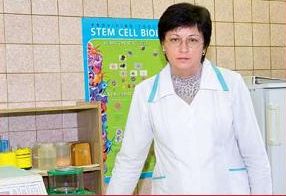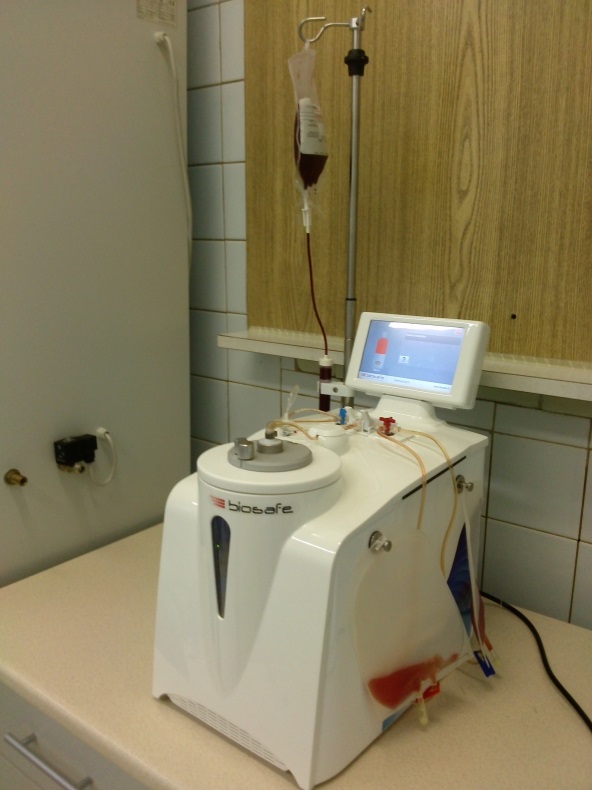Laboratory for Separation and Freezing of Bone Marrow (stem cell bank)

Chief of the Laboratory
Svetlana I. Dryk
Phone: +375 (17) 255-96-22, +375 (17) 255-99-28
The specialists of the laboratory process (concentrate, extract) bone marrow cells and peripheral blood stem cells and freeze them in a controlled-rate freezer. If necessary, the extracted cells may be stored in a biorepository in liquid nitrogen at temperatures below 196 C for a long time.
There is an umbilical cord blood stem cell bank in the laboratory (paid service). Collection and storage of umbilical cord blood stem cells is a new medical technology similar to medical insurance, because once collected, stem cells may be preserved for decades.
Stem cells are used to treat a range of genetic disorders and acquired diseases, including the diseases of the hematopoietic system, acute and chronic cardiovascular diseases, diseases of the endocrine and central nervous system, genetic disorders, diseases of the musculoskeletal system and severe injuries. We collect, process and store (20 years and longer) stem cells.
Are you expecting a baby? Make your baby a great present! Preserve the umbilical stem cells! Umbilical cord blood is the blood that remains in the umbilical cord and placenta after childbirth and is to be got rid of. Actually, umbilical cord blood is one of the best sources of stem cells.
We offer you a unique opportunity to preserve the stem cells. They may be used later, if necessary, to treat complicated diseases and they will 100% compatible with your child’s body. The risk of rejection is very low.
Your baby’s stem cells may also be used for therapies of your baby’s sisters or brothers. We will extract, freeze and store them in cryogenic freezers in the Stem Cell Bank.
If your baby or a first-degree relative happen to have a serious disease in future, you may use the stem cells to cure it.
What are the stem cells? Why should I preserve them?
Collection and storage of stem cells is a new medical technology, though the concept itself is not new. It is similar to medical insurance for your baby. Today, there are over 60 diseases and disorders that may be treated with the help of stem cells. In many cases, stem cell transplantation is the only way to safe a patient’s life. The unique thing about stem cells is that they are undifferentiated and may differentiate into specialized cell types. This ability of stem cells was recently discovered.
Thus, stem cells may produce any cells of the human body. Stem cell transplantation is widely used all over the world to treat cancer, genetic and congenital disorders.
Umbilical cord stem cells are younger and have a greater potency than the stem cells extracted from bone marrow. That is why that may easier differentiate into specialized cells. The concentration of stem cells in umbilical cord blood is higher than in an adult’s bone marrow or blood. Besides, it is much easier, cheaper and safer to extract them from umbilical cord blood.
If you bank umbilical cord stem cells, you may use them immediately. On the contrary, it may take years to find a bone marrow donor that is compatible to you.
Your baby will have a personal stem cell stock. You will have an opportunity to use umbilical cord blood when necessary.
How to collect umbilical blood? Is it dangerous for a baby or mother?
Collection of stem cells is absolutely safe and painless. Neither mother nor baby is involved in the procedure. Stem cells may be collected and preserved only during childbirth.
After the birth of the baby, an obstetrician gynecologist clamps and cuts the umbilical cord. Then, the obstetrician gynecologist collects the blood, which remains in the umbilical cord and placenta, into a sterile system. The collected blood is delivered to the stem cell bank, where the specialists extract stem cells from the umbilical cord blood. Stem cells, not umbilical cord blood, are stored in the bank.
What tests are made during processing of umbilical cord blood?
All samples of umbilical cord blood are tested for bacteria and viruses. We also define the blood group and Rhesus factor, test it for infections (hepatitis B and C, cytomegalovirus), calculate total number of cells and number of stem cells, evaluate viability of stem cells.
How stem cells are stored?
Stem cells are frozen and stored at temperatures below 196 C in liquid nitrogen. It is a safe and long-term method of storage.
Contraindications to stem cell preservation
If umbilical cord blood is positive for HIV, hepatitis B or C, syphilis, a bacterial or fungal infection, it is not suitable for a long-term storage.
A low quantity of stem cells in umbilical cord blood caused by a low volume of the collected umbilical blood is a relative contraindication for a long-term storage. If less than 40 ml of umbilical cord blood is collected, it is unreasonable to extract stem cells from it.
The first umbilical cord blood stem cell bank was opened in 1992 in the USA. Today, there are over 150 stem cell banks worldwide. Stem cells are stored with a view to using them if a child or its first-degree relative has a disease in future. The family is the sole owner of the stem cells. Since the patients pay for the collection, banking and storage of their baby’s umbilical cord blood, they may use it at their own discretion.
In Belarus, the umbilical cord blood stem cell bank is located in the 9th City Clinical Hospital (Minsk).
There are two ways to extract stem cells from umbilical cord blood: sedimentation and automatic method. Sedimentation is performed with the use of 6% hydroxyethyl starch. As far as the automatic method is concerned, stem cells are extracted with the help of an automatic stem cell separator Sepax (Biosafe, Switzerland). It is the world standard for stem cell extraction.

Sepax stem separator
The advantages of the automatic stem cell extraction method are:
- extraction of as many stem cells as possible;
- no human error;
- no risk of contamination of umbilical cord blood with microbial agents.
How to arrange storage of umbilical cord blood at the Stem Cell Bank of the 9th City Clinical Hospital?
Step 1: to look through the sample contract and annexes hereto at www.m9gkb.by or in the department of paid services of the 9th City Clinical Hospital.
Step 2: to contact us on +375 (17) 255-96-22, +375 (17) 255-96-28 and learn more about the procedure.
Step 3: to visit the 9th City Clinical Hospital from 8.00am to 3.30am on working days.
Step 4: to make a contract.
Note: please, provide the results of the tests specified in your prenatal record.